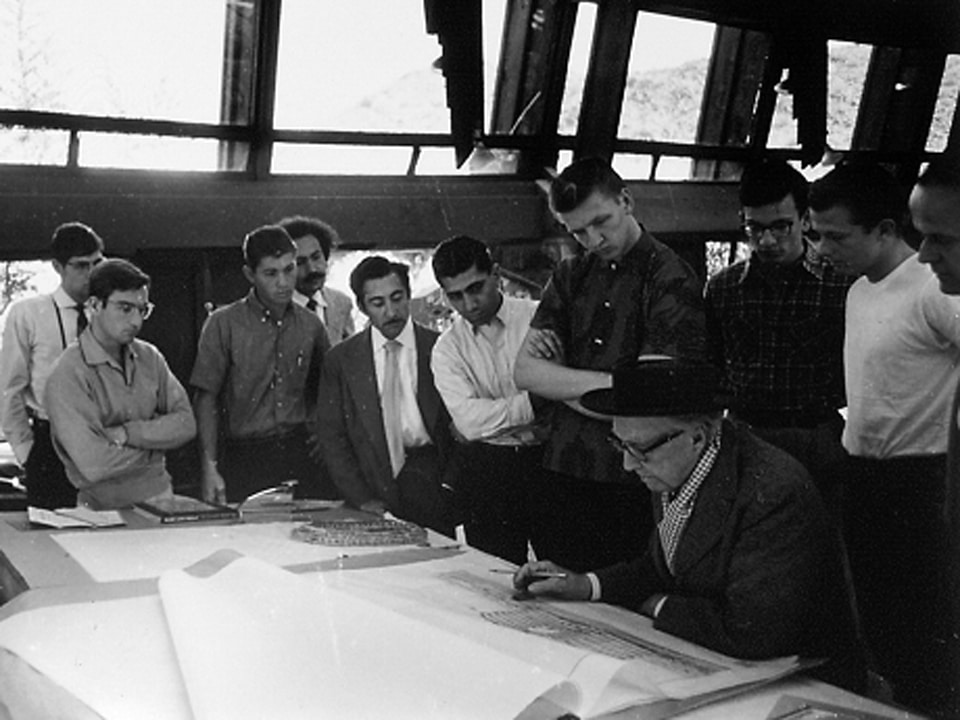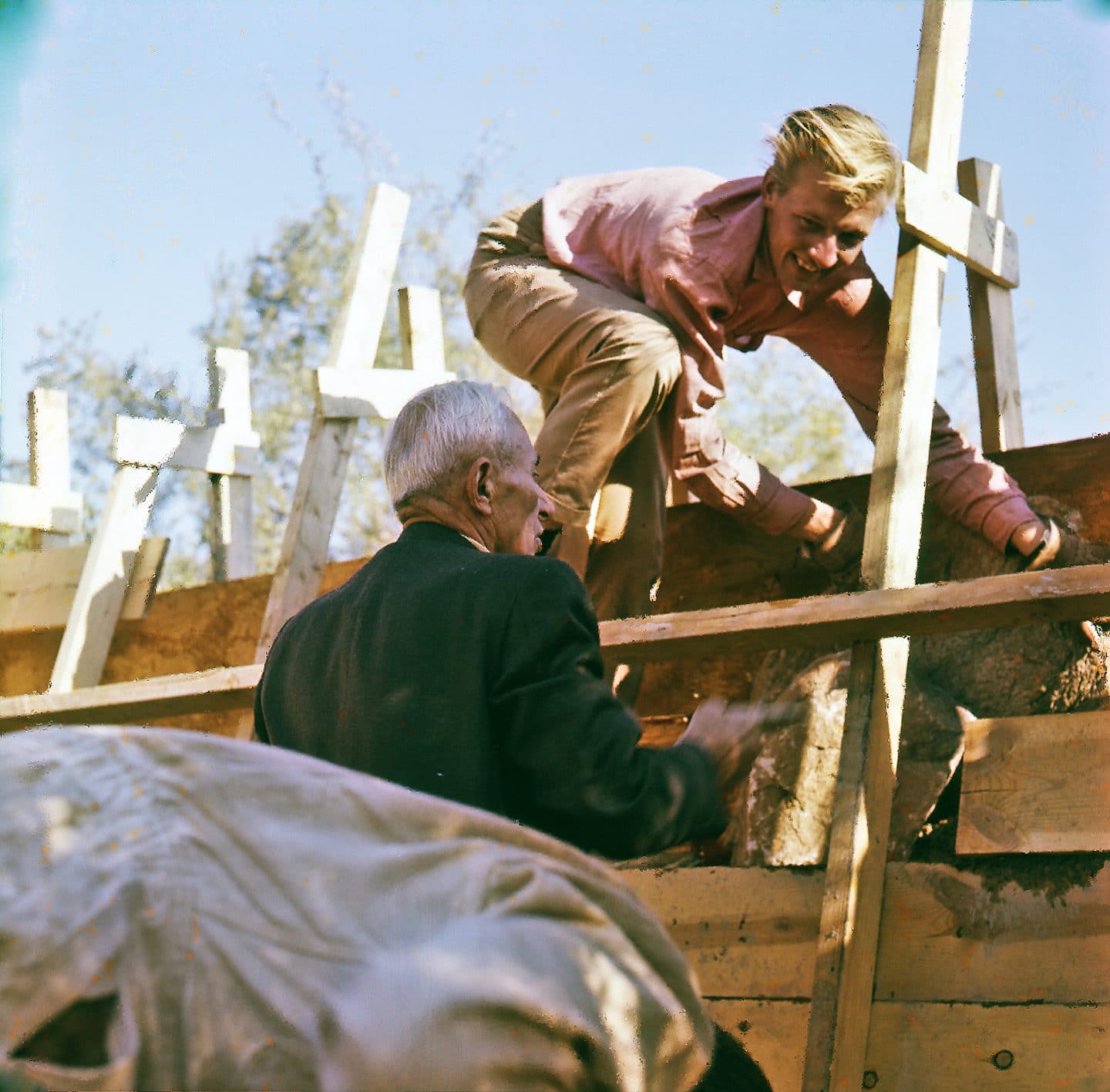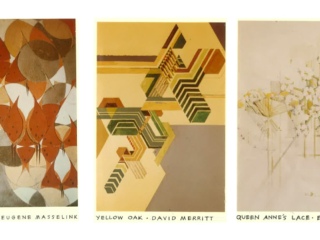
Frank Lloyd Wright’s Greatest Work
Vernon D. Swaback | May 16, 2017
Serving as an apprentice, resident, and practitioner from January 1957 to October 1978 at Taliesin West, Vern Swaback has experienced firsthand the many facets of the Taliesin experience. Now, he’s exploring how the past at Taliesin West continues to shape the future.
I have long been both intrigued and inspired by two related questions: What is it about the spirit of architecture that goes beyond being a collection of the world’s great houses and buildings? And, what is it about the work and life of Frank Lloyd Wright that makes him not only so enduringly famous, but also so needed? Related to these questions is my deeply held belief that his work and life will be increasingly revered in the indefinite future, especially in ways that place a far greater emphasis on the sustainable vibrancy of life.
In a variety of settings, nothing was more predictable than admirers of Mr. Wright asking what he considered to be his greatest work, to which he invariably responded, saying, “The next one.” By way of the seeds he planted for the future, his answer still applies. The difference is “the next one,” rather than being limited to the collection of his memorable houses or buildings, will go further to address entirely new and richly sustainable ways of living, not only in our more personal relationships with each other, but between all of us living in harmony with Nature. This new reality is not only something he described in words or drawings, but in the ways and means of his own everyday life, which he shared with individuals from all over the world.
Future Disruptors
As for what this might mean for the future, we should acknowledge that our emerging way of life will not only be unlike the present, but if we don’t get it right, it could be extremely threatening. Among the most obvious indicators of positive change are the increasing and accelerating use of social disruptors, along with the host of other technologies that are replacing ownership with shared use. Changes are going well beyond altering the fundamentals of daily life to redefining what it means to be human, in a somewhat oversimplified way.
In a recent discussion with a major developer and as part of describing and presenting the Taliesin experience as a look into the future, I concluded our conversation with these words from Wright’s philosophy, “I learned early in life that I could get along without the necessities, if only I could have the luxuries.” The developer practically jumped out of his chair responding with, “That sounds exactly like the Millennials.”
In addition to the relationship between Wright’s designing for how he lived and the needs of the future, we might ask if he wanted this connection to one day become the direction for what he saw to be humanity’s emerging future. The answer can be found in his 1958 publication of “The Living City,” which describes his concept for what he called “Broadacre City.” Of the concept’s 51 specifically identified land uses, number 43 is designated as “The Taliesin Equivalent.” The word “equivalent” is essential because there could be no way to replicate the original without the presence of its founders. What is beyond argument is that everything about the future is ushering in both the need and the behaviors to do more with less. This is the basis for believing that the influence of Frank Lloyd Wright will become more studied, more revered and increasingly critical to shaping the future than it has already been in the past.
Wright had no interest in what we so easily celebrate as trends or styles. Perhaps the most dramatic comparison is the degree to which we revere all things organic. At the time when Wright introduced his emerging philosophy of organic architecture, the word was so little used, that in order to explain what it meant, he resorted to saying, “By organic I don’t mean something hanging in a butcher shop.” Our growing appreciation for all things natural was also so basic to Wright’s way of seeing that he always put a capital “N” on Nature. In his words, he regarded this miraculous, totally integrated, life-giving and life-enriching source of all else to represent “the body of God.”
With this overview of Wright’s ideas, it is not only that which we have long revered about what Frank Lloyd Wright designed for others, but increasingly what he designed for his own way of life which was shared with others who came from all over the world to live, learn and work as part of his innovative, organic, green, smart and sustainable way of life. Founded in 1932, the community known as the Taliesin Fellowship began in the settings and buildings of his Wisconsin home, which he had previously named Taliesin. This was followed six years later by the heroic and well-documented creation of Taliesin West, in what was then the vast and mostly empty setting of the Sonoran desert.
I have had six decades to experience, study, and take an active role concerning the work and mission of the Frank Lloyd Wright Foundation, with my most recent thoughts being focused on the power and lessons of Taliesin West. My first 21 years of this experience were spent as a resident, apprentice, and practitioner, followed by the now more than 38 years of private practice, during which I served on the board of the Frank Lloyd Wright Foundation, and for a brief time, as both its Chairman and acting CEO. During the years of my apprenticeship, I kept extensive notes concerning whatever I could imagine about the Foundation’s future.
Taliesin West holds great significance in purposes relating to the future, not only with respect to the creative atmosphere of its Sonoran desert setting, but what can be learned from how this desert campus was created from the ground up. This will become increasingly significant, involving its ever-widening lessons and applications for the future.
Looking Back on a Forward Way of Life
As the use of social disruptors grows increasingly popular, consider the prominence of shared use over ownership as the simple everyday norm of the Taliesin experience. Provisions and spaces for work, exercise, study, exhibitions, performance, entertainment, central food preparation and dining areas were the most shared, while the personal spaces for sleeping, dressing and hygiene, small kitchens and dining areas, were as individual as the imaginations and desires of its citizens. There were far fewer cars than the number of residents, all made both possible and economical by the shared use of a stable of vehicles.
Society’s current and growing dominance of shared use is fast making what we long ago experienced at Taliesin more the norm of the present than anything to be considered unusual. Joe Gebbia, a designer and co-founder of Airbnb summarized this new norm of doing more with less by asking, “Do we really need to own a house, a car, or a boat? Things that were once available only after years of saving can now be easily accessible through the collaborative.” And what is radiating out at a globally-exponential scale, Gebbia summarized in just five words, “Access is the new ownership.”
In addition to shared use, efficiency and thoughtfulness were the nature of other everyday activities at Taliesin West. Fruits and vegetables were grown, harvested, and available on site, as much as possible. Like all other provisions demanded by the design of high-performance ships and aircraft, storage areas were highly organized, thus efficiently limited. Instead of the more typical division between residents and service people, the residents took part as stewards of their own treasured ways of living. Taliesin West’s cultural events included a diversity of community engagements, attended by a distinguished roster of guests, all of which provided for uncommon access for candid and enjoyable exchanges with extraordinary individuals and groups.
In a variety of ways, there was little difference between living and working. “Retirement” occurred more as a change of activity than anything to do with the cessation of work. Facilities for education, culture, and construction were simply an integral, enriching, and vital component of a stimulating way of life.

Header image: Mrs. Wright visits construction at Taliesin West with (left to right) Bill Owens, Tom Casey, Kamal Amin, Jack Howe, and Vern Swaback, circa 1960. Above: Vern Swaback, with arms folded, looks over Frank Lloyd Wright’s shoulder as he works on Swaback’s drawing of the Bramlett Motor Hotel.
The Taliesin West structures were not only designed with respect to climate-responsive considerations – including building materials, systems, and solar orientation – but were also maintained and operated with an ongoing sense of community celebrations and environmental stewardship. Perhaps most amazing of all is that this UNESCO World Heritage Site, was constructed from the ground up, by its own residents, using sand from the desert washes to produce the concrete, along with stone, gathered on-site as both the structure and richly ornamental and integrated character of its desert setting.
For all these reasons, our distinguished guests, who came from all over the world, were not only meeting with the community’s residents, but also its creators. The residents included those who came from modest backgrounds, to those of great wealth and even royalty, without any way for others to tell the difference between their backgrounds. Saturday evenings were always elegant, black-tie affairs, beginning with cocktails in the Taliesin West living room, followed by the gracious service of dinner in the Cabaret, all leading to the showing of first-run movies. Sunday evenings were similar, with the after-dinner entertainment provided by our own chorus, soloists, and chamber ensemble.
The nature of these gatherings created an opportunity for fascinating conversations with our distinguished guests which were educational, cultural and, at times, quite revealing. An example of the latter occurred when several of us were having a rather polite conversation with Henry Luce, the founder and publisher of Time, Life and Fortune magazines. The tone changed when Mark Hyman, one of our members asked, “Mr. Luce, does Life magazine have integrity?” Without the slightest hesitation, Luce responded with, “About 80 percent!”
Substantial conversations occurred with a wide diversity of individuals, including Mr. Luce’s wife, Clare Boothe Luce, an author, playwright, and U.S. Ambassador to Italy. Other guests included artist Georgia O’Keeffe, poet Carl Sandburg, actress Elizabeth Taylor, guitarist Jimi Hendrix, conductor of the Chicago Symphony, Georg Solti; father of the Hydrogen Bomb, Edward Teller; the founder of Planned Parenthood, Margaret Sanger; and Buckminster Fuller, a hero to many of today’s most innovative individuals.
Understanding the present
During my time as part of the Taliesin West experience, we somewhat begrudgingly conducted tours for the occasional visitor. I note that it was done begrudgingly, because conducting tours meant stopping whatever we were doing in the drafting room or in the wide variety of other engagements. As a result of one such occurrence, I was directed by Mrs. Wright to handle a tour-related complaint which she had just received by way of a letter from a very dissatisfied visitor. This woman’s complaint was focused on the Taliesin person who, in her words, seemed more interested in getting back to whatever he was doing than to serve as her party’s tour guide. I dutifully called the woman to apologize on behalf of the guide, assuring her that we would identify and speak to the individual, in order to make certain that what she experienced would never happen again. My problem was that I had to be convincing without revealing that her description made it unmistakably clear that I had been the offending guide.
A half century later, the roles are now reversed. Rather than the dominant energy and focus of the work at Taliesin West being on itself, the campus has become a magnetically growing attraction for visitors from all over the world who come in droves to learn about Taliesin West’s innovative ways of living and everything that went into making it possible for it to serve as a rich, varied and creative environment for all. The dominant and expanding focus of the setting, along with its vibrant history, is clearly one of conveying the historically valuable lessons that were once made possible by the few, and are now reaching out with economic and cultural benefits for the many.
We are all living in a two-world reality, one world includes consideration for the future while the other consists of assumptions of the past. It would be an understatement to suggest how little awareness there is about the accelerating changes that are affecting daily life, in ways that are not unlike the past. This will be increasingly challenging or, by way of design, could be beneficial for the future. Frank Lloyd Wright was not only an architect who epitomized and shaped the culture of his time, but also a prophet, who embraced the possibilities for the future. It has now been a century since he delivered his famous lecture at Chicago’s Hull House, which he named, “The Art and Craft of the Machine.” At that time and continuing throughout his lifetime, he always viewed technology as a tool rather than anything to be considered as an end in itself. “Standardization should be put to work but never in such a way that it commands the process which yields the original form,” Wright said. Not only was this a difficult case to make concerning the technology of the time, to do so today requires looking well beyond the most tantalizing provisions of technology that dominate center stage.
Community Spirit of Innovation
The measure of our human success or failure is ultimately a matter of our relationships both with each other and in concert with nature, which is a pretty good definition of community. We are on the verge of understanding that community is not only essential to our success but to our very survival, and never more so than at this time of great and accelerating change. This is further exacerbated by those who believe that the heavy lifting confronted in pursuit of all things human can now be replaced by the miracles of all things technological. The problem with this way of thinking is not what it measures but what it ignores.
To live in the ways and means of Wright’s life was to experience a sense of strength and creativity that was greater than what could be achieved by totaling the contribution of its individual members. This was not at all unlike the dynamics of a winning team or the performance of a great symphony orchestra. The obvious difference being that the experience went beyond a series of special events to achieve a more fundamental and richer way of life.
All this may seem a bit too philosophical to adequately describe the great variety of issues that so easily influence or even dominate our lives. My only response is that this was not only my way of life, but I now see that experience as being one of increasingly relevant significance, for as many applications as there are creatively engaged individuals and interests.
At the end of his last stay at Taliesin West, the late Buckminster Fuller, or Bucky, as he was known by his friends and admirers, summed up the necessity of the community’s spirit of innovation by writing on one of his Dymaxion Maps left for the Taliesin archives, “To the Taliesin Fellowship, an oasis of the regenerative spirit.”
Wright went beyond the significance of his own creations to engage the community’s sense of the day-to-day connection. “Whether people are fully conscious of this or not, they actually derive countenance and sustenance from the atmosphere of the things they live in or with,” Wright said. “They are rooted in them just as a plant is in the soil in which it is planted.”
Vernon D. Swaback has been inducted into the College of Fellows by both the American Institute of Architects and the American Institute of Certified Planners. He is the Founder and Managing Partner of Swaback Partners, Architecture and Planning and Studio V, Interior Design, the president of the nonprofit Cattletrack Arts and Preservation and the Founder and Chairman of the 501(c)3 Two Worlds Community Foundation. He has written extensively about his Taliesin experience, including his most recent publication, “Designing for the Life of Community at a Time of Great Change.”
This article originally appeared in the Winter 2017 issue of the Frank Lloyd Wright Quarterly, “Taliesin West: The Desert Laboratory.”




